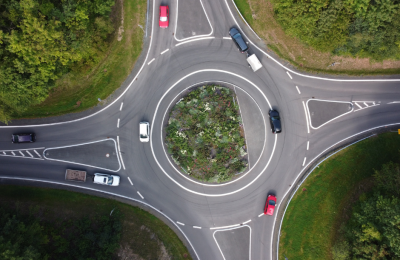Roundabouts
Roundabouts are circular intersections where all traffic moves counterclockwise around a central island. Compared to traditional stop signs or traffic signals, roundabouts offer several advantages: they’re safer, more efficient, lower maintenance, and better for the environment—and they even offer a chance to beautify the area.
Roundabout Safety
Roundabouts reduce the risk of serious crashes by slowing vehicle speeds and eliminating dangerous left turns. According to national studies, converting intersections to roundabouts can result in:
- 40% fewer collisions
- 75% fewer injury collisions
- 90% fewer fatal or incapacitating crashes
Additional Benefits
- Less Delay: Drivers yield at entry points instead of stopping, keeping traffic moving.
- Environmental impact: Fewer stops = less idling. Studies show up to:
- 29% less carbon monoxide
- 21% less nitrous oxide
- 30% less fuel consumption
- Bicycle-friendly: Slower speeds make roundabouts safer for cyclists.
- Lower Maintenance: No traffic lights = no electrical or signal maintenance costs.
- Increased Capacity: Yielding instead of waiting for a green light reduces congestion.
- Visual Appeal: The center island offers space for landscaping or community features.
Do Roundabouts Improve Traffic Flow?
Yes. Multiple studies show significant traffic improvements after replacing traditional intersections with roundabouts. In one case, researchers found that using roundabouts instead of signals at 10 urban intersections could have reduced vehicle delays by 62–74%—equivalent to about 325,000 hours saved per year.
What About Larger Vehicles?
Roundabouts are designed to handle large vehicles like trucks and buses. They include a truck apron—a slightly raised, colored section around the central island that larger vehicles can drive over safely. This design keeps traffic flowing while maintaining safety for smaller vehicles.
Pedestrian Safety
Roundabouts are generally safer for pedestrians than traditional intersections. Here’s why:
- Pedestrians only cross one direction of traffic at a time
- Traffic moves more slowly
- Crossing distances are shorter
- Fewer conflict points
Studies show that converting traditional intersections to roundabouts can reduce pedestrian crashes by about 75%—especially at single-lane roundabouts.
How to Navigate a Roundabout
- Slow down as you approach
- Yield to pedestrians in the crosswalk
- Look left and yield to traffic already in the roundabout
- Enter when there's a safe gap
- Drive counterclockwise around the center island
- Signal before exiting, and check for pedestrians
- Stay in your lane, and never stop in the roundabout
For more information on how roundabouts improve traffic flow, view the supporting documents linked below.

